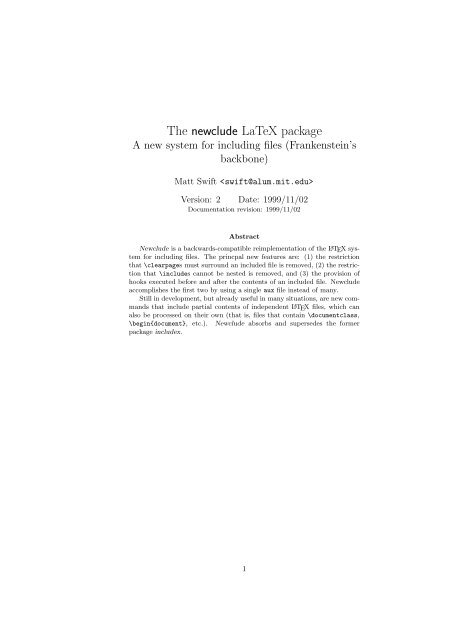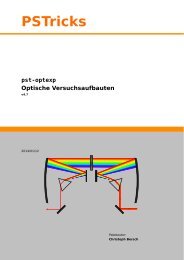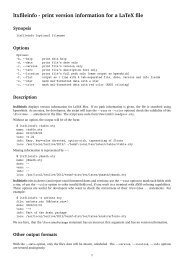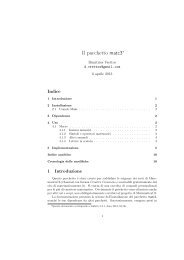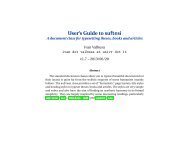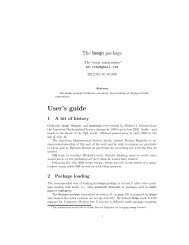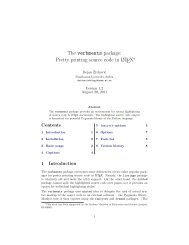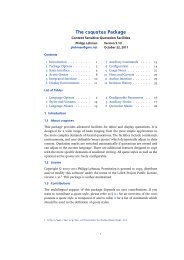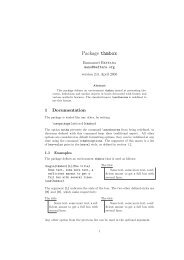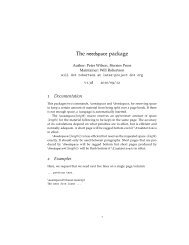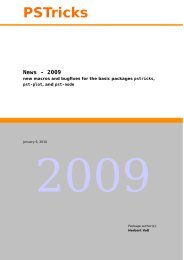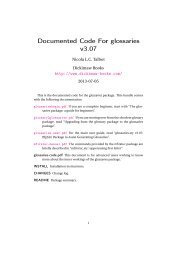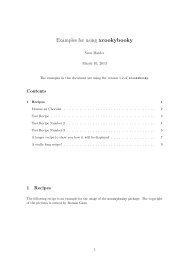You also want an ePaper? Increase the reach of your titles
YUMPU automatically turns print PDFs into web optimized ePapers that Google loves.
The <strong>newclude</strong> LaTeX package<br />
A new system for including files (Frankenstein’s<br />
backbone)<br />
Matt Swift <br />
Version: 2 Date: 1999/11/02<br />
Documentation revision: 1999/11/02<br />
Abstract<br />
Newclude is a backwards-compatible reimplementation of the LATEX system<br />
for including files. The princpal new features are: (1) the restriction<br />
that \clearpages must surround an included file is removed, (2) the restriction<br />
that \includes cannot be nested is removed, and (3) the provision of<br />
hooks executed before and after the contents of an included file. Newclude<br />
accomplishes the first two by using a single aux file instead of many.<br />
Still in development, but already useful in many situations, are new commands<br />
that include partial contents of independent LATEX files, which can<br />
also be processed on their own (that is, files that contain \documentclass,<br />
\begin{document}, etc.). Newclude absorbs and supersedes the former<br />
package includex.<br />
1
Contents<br />
I Discussion 3<br />
1 Introduction 3<br />
2 Usage 3<br />
3 Experimental features 5<br />
4 Options 6<br />
4.1 Simple . . . . . . . . . . . . . . . . . . . . . . . . . . . . . . . . . . 6<br />
4.2 Tag. . . . . . . . . . . . . . . . . . . . . . . . . . . . . . . . . . . . 7<br />
4.3 Allocate . . . . . . . . . . . . . . . . . . . . . . . . . . . . . . . . . 7<br />
5 Programmers’ interface 8<br />
6 How to play nicely with <strong>newclude</strong> 8<br />
II Implementation 10<br />
7 Version control 10<br />
8 Review of the kernel’s inclusion system 10<br />
9 Discussion of <strong>newclude</strong>’s inclusion system 11<br />
10 Package initialization 11<br />
11 Simple 12<br />
12 Common 13<br />
13 Experimental common 14<br />
14 Tag 17<br />
14.1 Writing to \@auxout . . . . . . . . . . . . . . . . . . . . . . . . . . 17<br />
14.2 Kernel redefinitions . . . . . . . . . . . . . . . . . . . . . . . . . . . 17<br />
14.3 Checkpoints . . . . . . . . . . . . . . . . . . . . . . . . . . . . . . . 19<br />
14.4 Including . . . . . . . . . . . . . . . . . . . . . . . . . . . . . . . . 19<br />
15 Allocate 23<br />
15.0.1 Wheels . . . . . . . . . . . . . . . . . . . . . . . . . . . . . 23<br />
15.0.2 Preliminaries . . . . . . . . . . . . . . . . . . . . . . . . . . 24<br />
15.0.3 Static allocation . . . . . . . . . . . . . . . . . . . . . . . . 25<br />
15.0.4 Dynamic allocation . . . . . . . . . . . . . . . . . . . . . . . 26<br />
15.0.5 Including . . . . . . . . . . . . . . . . . . . . . . . . . . . . 26<br />
15.0.6 Checkpoints . . . . . . . . . . . . . . . . . . . . . . . . . . . 28<br />
15.0.7 Wheels . . . . . . . . . . . . . . . . . . . . . . . . . . . . . 29<br />
2
16 Benign packages 29<br />
3
\include<br />
\AtBeginInclude<br />
\AtEndInclude<br />
Part I<br />
Discussion<br />
1 Introduction<br />
Let us call a file that might be included into another document with a command in<br />
the \include family a part. When a part is actually included during a particular<br />
processing run, let us call it an included part, and when it is not included, let us<br />
call it an unincluded part. Notice that an unincluded part is not the same as a file<br />
that was never a candidate for inclusion with a command in the \include family.<br />
The <strong>newclude</strong> package adds these features to the standard LaTeX inclusion<br />
system:<br />
1. Hooks \AtBeginInclude and \AtEndInclude are provided.<br />
2. Optional arguments to \include and friends override current values of<br />
\AtBeginInclude and \AtEndInclude.<br />
3. \include* is like \include but with arbitrary commands rather than<br />
\clearpages surrounding the part.<br />
4. \include and friends can be nested.<br />
5. \includeall cancels the effect of \includeonly.<br />
6. \IfAllowed 〈filename〉 is a new conditional that branches, depending on<br />
what has been declared in an \includeonly.<br />
7. Commands \includedoc etc. include a part that can be processed independently.<br />
These features are in development.<br />
Newclude accepts three mutually-exclusive package options, with tag the default<br />
when no package option is given.<br />
Loading <strong>newclude</strong> with the simple option provides only features 1 and 2. If<br />
you don’t use either of these new features, the standard L ATEX and<strong>newclude</strong><br />
inclusion systems will behave identically except in some unusual and benign odd<br />
cases relating the the parsing of the new optional arguments to \include, which<br />
are discussed below in that command’s documentation.<br />
The options tag and allocate each implement all the above features with a<br />
different method. Each method introduces different discrepancies from standard<br />
L ATEX which are discussed below in sections 4.2 and 4.3. If I discover how to make<br />
one method never inferior to the other, I will remove the other option from the<br />
package.<br />
2 Usage<br />
\include [〈prehook〉]{〈filename〉}[〈posthook〉] behaves like standard LATEX’s \include except that it can be nested and the contents of the two hook arguments,<br />
when they are given, are inserted at the beginning and end of the part<br />
whenever it is included, overriding the current values of \AtBeginInclude and<br />
\AtEndInclude.<br />
4
\include*<br />
\IncludeSurround<br />
\DefaultIncludeSurround<br />
\includeonly<br />
\includeall<br />
Warning: Right square braces (]s) in the optional arguments must be surrounded<br />
by curly braces to avoid confusing the argument parser.<br />
Warning: A left square brace ([) that immediately follows an \include<br />
command’s mandatory 〈filename〉 argument (after optional whitespace) will be<br />
considered to delimit the beginning of the 〈posthook〉 argument. If you want an<br />
actual left brace character in this position, you must precede it with something<br />
that will terminate TEX’s search for an optional argument, such as \relax, ,ora<br />
paragraph division (explicit or implicit).<br />
The commands \AtBeginInclude 〈tokens〉 and \AtEndInclude 〈tokens〉 are<br />
analagous to standard L ATEX’s commands \AtBeginDocument 〈tokens〉 and \AtEndDocument<br />
〈tokens〉.<br />
FIX: multiple instances concatenate?<br />
FIX give name to what’s held by atbegininclude so that an override can mention<br />
it<br />
When the optional argument 〈prehook〉 is given to \include, its contents will<br />
be used instead of whatever has been specified with \AtBeginInclude, for that<br />
one inclusion. Likewise, 〈posthook〉 will be used in place of whatever has been<br />
specified with \AtEndInclude for that one inclusion.<br />
For example, putting the \chapter declaration in the 〈prehook〉 argument<br />
allows the chapter name, and, optionally, a corresponding L ATEX label, to be kept<br />
in the including file, rather than the included file:<br />
\include [\chapter{Whales}<br />
\label{ch:whales}]<br />
{big-cetecea}<br />
The 〈posthook〉 argument can be used, for example, to delimit or undo declarations<br />
made in the 〈prehook〉 or the included file: FIX: better example, since<br />
these coudl simple appear before/after the \include without ill effect.<br />
\include [\begingroup\larger] % this part in larger type<br />
{manifesto}<br />
[\endgroup]<br />
\include*[〈prehook〉]{〈filename〉}[〈posthook〉] is like \include but omits<br />
the usual \clearpages that surround an included part, replacing them with<br />
\IncludeSurround, which defaults to \DefaultIncludeSurround. The contents<br />
of \IncludeSurround are inserted before the 〈prehook〉 or whatever has been<br />
specified with \AtBeginInclude, and after the 〈posthook〉 or whatever has been<br />
specified with \AtEndInclude.<br />
Warning: A space gets inserted after an \include* unless it is suppressed<br />
by a immediately following. Combined with trailing spaces in the included file,<br />
this may lead to unwanted spaces. For this reason, \DefaultIncludeSurround<br />
is initialized to \par. When the user must explicitly change \IncludeSurround<br />
to achieve totally smooth flow from main file to included file, they are more likely<br />
to consult this documentation if they spot a problem. Package and class writers<br />
should take this difficulty into account when changing \DefaultIncludeSurround.<br />
The \includeonly command is reimplemented, but its usage and behavior is<br />
the same as the standard LATEX version.<br />
The \includeall command cancels the effect of any \includeonly command<br />
presently in effect.<br />
5
\includeenv<br />
If you write an \includeonly so that each file appears on its own line, it is<br />
particularly easy to add and remove files to include by commenting out their lines,<br />
but it becomes laborious to comment out the entire \includeonly command. It’s<br />
easy, however, to uncomment a single \includeall command when you want<br />
to process the entire document. (Or \includeall could be inserted from the<br />
command line that invokes L ATEX, and so on.)<br />
3 Experimental features<br />
\includeenv [〈prehook〉]{〈filename〉}{〈environment name〉}{〈instance〉}[〈posthook〉]<br />
\includeenv *[〈prehook〉]{〈filename〉}{〈environment name〉}{〈instance〉}[〈posthook〉]<br />
\includeenv includes the contents of a single LATEX environment that appears<br />
in 〈filename〉. The environment is specified by giving its name (〈environment〉)<br />
and an instance of that environment in the file (〈instance〉). Presently, 〈instance〉<br />
is ignored, so that it will always be the contents of the first occurrence in 〈filename〉<br />
of a LATEX environment with the name 〈environment〉 that will be included. In<br />
the future, the 〈instance〉 argument may be used to specify the nth instance of the<br />
environment within the file, or further specify the environment to be extracted in<br />
some other way.<br />
FIX: right now they’re required; skip text up to documentclass OR the target,<br />
then branch?<br />
Good preamble syntactic sugar: \let\TheMarkupDeclarations\begin<br />
To do: You can insert a \usepackage into the main aux file and have it<br />
loaded properly. If we discover a \usepackage that is not a formatting package,<br />
one strategy is to insert a corresponding \usepackage into the (main) aux file<br />
and then bail after the preamble.<br />
To do: You can’t skip verbatim text via macro argument processing and sugar.<br />
this means that a major reimplementation of skipping using verbatim methods will<br />
have to be done.<br />
The included file is permitted (but not required) to have its own \documentclass<br />
command and \begin{document} ...\end{document} pair. \includeenv extracts<br />
the specified environment by processing the preamble if one exists, skipping<br />
text up until the beginning of the specified environment, processing the contents<br />
of the environment, and skipping the rest of the included part.<br />
Notice that while a \begin{document} ...\end{document} pair may not<br />
technically delimit a LATEX environment, you may nevertheless (because it looks<br />
exactly like an environment) set 〈environment〉 to document to extract the contents<br />
of the document “environment” of 〈filename〉.<br />
Consider the following issues when you are tempted to use this command.<br />
Maybe the \usepackage you are about to disregard is necessary to processing<br />
the part’s contents. Maybe it conflicts with a package already loaded at top<br />
level. Maybe both! The same holds of course for the defining commands like<br />
\newcommand that one expects to find in a package.<br />
A deep problem with the design of a LATEX source file exists with respect to<br />
the function of the preamble. The preamble contains declarations that determine<br />
how the document below will be formatted. Unfortunately, there is no way to<br />
make the distinction between:<br />
1. declarations that signal that certain markup will appear in the document<br />
6
that are either not defined in the L ATEX kernel or are used with a different<br />
syntax<br />
2. declarations that describe how a certain instance of the document should be<br />
formatted<br />
Examples in the first category are \usepackage{url} and FIX%example, andexamples<br />
in the second are \usepackage{times} and FIX. When you want to include<br />
the document or a part of it in another document, it is absolutely necessary to<br />
make this distinction so that declarations in category (1) can be processed and<br />
declarations in category (2) can be ignored.<br />
Adopting a convention on the use of the preamble can overcome this design<br />
problem, but it will not fix the problem for legacy files whose preambles do not<br />
obey the convention. Legacy files that contain category (1) declarations in their<br />
preambles must either be altered or specifically accommodated with additional<br />
commands.<br />
The convention I suggest is to \usepackage{preamble}. \beginmarkup<br />
\endmarkup. FIX. Can we arrange to load<br />
When \includeenv encounters a \usepackage command in the included<br />
part, it looks at the packages in the argument of \usepackage and issues<br />
a warning if the package is not already loaded and does not appear on a<br />
list of packages known whose use falls entirely within category (2). (See the<br />
\DeclareFormattingPackage command below.)<br />
The \documentclass command is of course also a category (1) declaration.<br />
Presently, if \includeenv detects that the arguments to an included<br />
\documentclass command differ from the arguments of the \documentclass<br />
command of the including document, it will issue a warning, and continue. In<br />
the future, I hope to make this behavior smarter by having \includeenv take<br />
specific actions for specific combinations of arguments. For example, if the included<br />
document’s class implies the use of markup not defined in the parent’s<br />
class, an appropriate action would be to define the missing markup commands. A<br />
document of class report and a document of class article, on the other hand, do<br />
not (I don’t think) declare different markup, so that there should be no warning<br />
in this case.<br />
\includeenv* \includeenv* is analogous to \include*, that is, it surrounds the included<br />
part with \IncludeSurround rather than \clearpage.<br />
\includedoc \includedoc [〈prehook〉]{〈file name〉}[〈posthook〉] is shorthand for \includeenv<br />
\includedoc* [〈prehook〉]{〈filename〉}{〈document 〉}{〈〉}[〈posthook〉].<br />
\includedoc* is analogous to \includeenv*.<br />
4 Options<br />
4.1 Simple<br />
If the simple option is given, the only new feature provided is the hooks (features<br />
1 and 2 above). As with standard L ATEX, \clearpages surround an \include<br />
and nesting \includes gives an error. Newclude will only behave differently than<br />
standard L ATEX command scans for possible optional arguments will make a different.<br />
7
4.2 Tag<br />
The tag option causes L ATEX to use just one aux file. This option, which is the<br />
default, works well. I am aware of the following two differences from the kernel’s<br />
including system:<br />
1. If the LATEX process is stopped during the processing of a part, all information<br />
normally stored in an aux file from that point in the document forward<br />
is lost. In the kernel’s system, processing the document twice more would<br />
recover any aux information previously generated for parts.<br />
If LATEX is always invoked in \nonstopmode (e.g., by AUC-TEX), then this<br />
difference is only going to occur when there are catastrophic errors that<br />
cause even \nonstopmode to terminate processing.<br />
2. Other packages and classes that redefine kernel commands that write to<br />
\@auxout will cause problems.<br />
The first difference must be accepted. The second difference can be removed<br />
on a case by case basis, by specifically coding compatibility with such packages<br />
and classes. I intend to do this. Here is a list of such packages and classes known<br />
to me:<br />
〈none so far〉 If you discover any more for this list, please write me!<br />
It’s also very easy to revise the other package to be compatible with <strong>newclude</strong><br />
as it is now. See section 6 below, which includes a list of relevant kernel commands.<br />
4.3 Allocate<br />
The second way (the allocate option) represents my first attempt at a solution,<br />
and until I am sure it has no advantages over tag under any circumstances, it will<br />
continue to be an option.<br />
The allocate option causes L ATEX to dynamically allocate TEX output streams<br />
to each part as they are needed. Streams are allocated when processing of the part<br />
begins, and are reclaimed after the ejection of the last page to which the part has<br />
contributed. Like the old system, a separate aux file is created for each part. The<br />
limitation of this implementation is that TEX only possesses 16 output streams.<br />
Each of the commands \tableofcontents, \listoffigures, \listoftables,<br />
\makeglossary, and\makeindex causes L ATEX to use one output stream. The<br />
remainder (minus any streams required by packages and classes) are available for<br />
the including system. If n streams are available, the level of nesting possible is<br />
n − 1 minus the maximum number of parts that occur on the same page. For<br />
example, if 10 streams are available and the parts never appear on the same page<br />
(the old behavior required by the \clearpages), then 8 levels of nesting are possible<br />
(which is 8, not 7 more than with the old system). The maximum number of<br />
parts that may contribute the to same page is calculated with the same equation.<br />
Note: TEX’s page-breaking algorithm looks ahead until it has more than enough<br />
material to fill one page. You must count all the new aux files that are opened<br />
during a look-ahead as contributing to the page in question, even if some of the<br />
later ones do not actually contribute to the page after the break is chosen.<br />
The allocate solution is itself implemented in two ways. The system either<br />
reserves a fixed number of output streams from the start, or will dynamically claim<br />
and free them as needed. The dynamic solution is the default. I do not see much<br />
8
\IfAllowed<br />
\IncludeName<br />
\ParentName<br />
\DeclareFormattingPackage<br />
\ifSkipPreamble<br />
\SkipPreambletrue<br />
\SkipPreamblefalse<br />
\Disable<br />
\DisableAll<br />
use for the static solution at present. If the dynamic system claims streams that<br />
are later required, then it is simply a question of whether <strong>newclude</strong> or the other<br />
feature is going to signal an error about having no more streams to allocate.<br />
5 Programmers’ interface<br />
\IfAllowed {〈part name〉}{〈true〉}{〈false〉} executes 〈true〉 if 〈part-name〉 is on<br />
the list of files to be included and 〈false〉 otherwise. If there is no list, executes<br />
〈true〉.<br />
\IncludeName expands to the name of the part currently being processed. In<br />
the toplevel source file, it will expand to \jobname.<br />
\ParentName expands to the name of the part that includes the part currently<br />
being processed. In the toplevel source file, expanding \ParentName will generate<br />
a warning and expand to \jobname (which is also what \IncludeName expands<br />
to).<br />
FIX: root source file? toplevel? master? principle source? glossary!<br />
\DeclareFormattingPackage {〈package name〉} declares 〈package name〉 to<br />
be a package that only makes formatting declarations, that is, the effect of using it<br />
falls entirely within category (2). If a formatting package occurs in a \usepackage<br />
declaration in the preamble of a part included by \includeenv, no warning will<br />
be given. An example of a formatting package is the times package. No facility is<br />
provided to distinguish the case when a package is used with or without certain<br />
package options, so do not declare a package as a formatting package unless it is<br />
so regardless of the options it is passed.<br />
If you send me the names of formatting packages, I will include them in the<br />
next release of <strong>newclude</strong>. Meanwhile, you may declare them in <strong>newclude</strong>.cfg.<br />
Do the same for your local formatting packages if you wish. It does no harm to<br />
declare a package as a formatting package more than once.<br />
\Disable {〈tokens〉} provides a way to ignore additional commands when<br />
using \includeenv and friends. If you want to cause the macro \foo which takes<br />
no arguments to be entirely ignored in parts, issue the command \Disable{\let\<br />
foo\relax} any time before including the parts you want to affect. If \foo takes<br />
one mandatory argument, write \let\foo\Gobble instead. If \foo takes one<br />
optional and one mandatory, write \let\foo\GobbleOM. And so on. For other<br />
examples, see the gobbling commands in the moredefs package (which <strong>newclude</strong><br />
requires), or write your own.<br />
The arguments to \Disable are accumulated and executed by the command<br />
\DisableAll, which is executed inside a group that contains a part when it is<br />
included.<br />
There is no way to undo the effect of issuing a \Disable command.<br />
6 How to play nicely with <strong>newclude</strong><br />
To adapt a package or class for use with the tag option of <strong>newclude</strong>:<br />
1. replace \immediate\write\@auxout with \@writeaux<br />
2. replace \protected@write\@auxout with \protected@writeaux<br />
9
3. add<br />
\providecommand\@writeaux {%<br />
\immediate\write\@auxout<br />
}<br />
\providecommand\protected@writeaux {%<br />
\protected@write\@auxout<br />
}<br />
10
\fileinfo<br />
\DoXUsepackagE<br />
\HaveECitationS<br />
\fileversion<br />
\filedate<br />
\docdate<br />
\PPOptArg<br />
Part II<br />
Implementation<br />
7 Version control<br />
These definitions must be the first ones in the file.<br />
1 \def\fileinfo{A new system for including files (Frankenstein’s backbone)}<br />
2 \def\DoXPackageS {}<br />
3 \def\fileversion{v2}<br />
4 \def\filedate{1999/11/02}<br />
5 \def\docdate{1999/11/02}<br />
6 \edef\PPOptArg {%<br />
7 \filedate\space \fileversion\space \fileinfo<br />
8 }<br />
If we’re loading this file from a \ProcessDTXFile command (see the compsci<br />
package), then \JusTLoaDInformatioN will be defined; othewise we assume it is<br />
not (that’s why the FunkY NamE).<br />
If we’re loading from \ProcessDTXFile, we want to load the packages listed in<br />
\DoXPackageS (needed to typeset the documentation for this file) and then bail<br />
out. Otherwise, we’re using this file in a normal way as a package, so do nothing.<br />
\DoXPackageS, if there are any, are declared in the dtx file, and, if you’re reading<br />
the typeset documentation of this package, would appear just above. (It’s OK to<br />
call \usepackage with an empty argument or \relax, bytheway.)<br />
9 \makeatletter% A special comment to help create bst files. Don’t change!<br />
10 \@ifundefined{JusTLoaDInformatioN} {%<br />
11 }{% ELSE (we know the compsci package is already loaded, too)<br />
12 \UndefineCS\JusTLoaDInformatioN<br />
13 \SaveDoXVarS<br />
14 \eExpand\csname DoXPackageS\endcsname\In {%use \csname in case it’s undefined<br />
15 \usepackage{#1}%<br />
16 }%<br />
17 \RestoreDoXVarS<br />
18 \makeatother<br />
19 \endinput<br />
20 }% A special comment to help create bst files. Don’t change!<br />
Now we check for L ATEX2e and declare the LaTeX package.<br />
21 \NeedsTeXFormat{LaTeX2e}<br />
22 \ProvidesPackage{<strong>newclude</strong>}[\PPOptArg]<br />
8 Review of the kernel’s inclusion system<br />
One aux file is written to disk for the principle source and one for each of the<br />
included parts. The reason to have a separate ones for the parts is so that information<br />
from the last time the part was included is retained in subsequent runs<br />
even when the part is excluded by \includeonly. Suppose a part is processed<br />
once, and on a subsequent run its name is removed from the \includeonly list.<br />
This run will still read in the part’s aux file, since the aux file of any part that<br />
was \included during the last run is always read. But the information therein is<br />
11
not going to be regenerated in this run, since the part will not be processed. The<br />
main aux file is created anew with each run, so this information would be lost if<br />
it resided there.<br />
To handle writing these multiple aux files, the kernel uses two of TEX’s output<br />
streams. When a routine writes to an auxiliary file, it writes to \@auxout, which<br />
is \let to either \@mainaux, theaux file for the principle source, or \@partaux<br />
the aux file for all the parts each in turn.<br />
When encountering an \include command, but before deciding whether or<br />
not to actually load the part, the kernel writes a command to \@mainaux that will<br />
load the part’s aux file. The main aux file is loaded by \document, sothatall aux<br />
files are read in every time the principle source is processed.<br />
If a part is actually loaded, a checkpoint is written to the part’s aux file consisting<br />
of a snapshot of the counters (a record of the values of all L ATEX counters).<br />
On the next run, if the part is not actually loaded, the information in its aux file<br />
has nevertheless already been processed by \document. Processing the checkpoint<br />
causes a macro to be defined that when invoked restores the counter state. When<br />
\include does not actually load a part it calls this checkpoint macro instead to<br />
alter the present counter state.<br />
This system has pitfalls as well as benefits. It is useful to keep the bibliography,<br />
citations, cross references, and page numbers up to date in certain situations, but<br />
the results can be confusing sometimes, because checkpoints are not documented.<br />
(Perhaps this is remedied in the 2d edition of the L ATEX manual.) How, besides<br />
reading the code, or finding out the hard way, is anyone supposed to guess that<br />
rearranging two “deactivated” \include statements in a principle source will bring<br />
havoc on the page numbers?<br />
9 Discussion of <strong>newclude</strong>’s inclusion system<br />
Thesimpleremovalofthe\clearpages that surround an included part would<br />
cause a problem involving the delayed action of \write commands. Suppose a<br />
part ending with a \write command ends halfway down a page, and another<br />
\write occurs in the principle source immediately (or soon) after the inclusion.<br />
Thefirstmustbewrittento\@partaux and the second to \@mainaux. If we<br />
close \@partaux while the first \write is still pending, that is, before the current<br />
page has been shipped out, then the \write will be destined for a closed stream<br />
and therefore go to the log file and terminal. The \clearpages solvethisby<br />
flushing all pending \writes. Then we can close \@partaux immediately and<br />
reopen \@mainaux.<br />
Successful removal of the \clearpages can be accomplished either by having<br />
the entire document use just one auxiliary file, or by allocating additional output<br />
streams so that it becomes possible to avoid closing \@partaux until after the<br />
current page is shipped out when all the \write’s to it have been completed.<br />
10 Package initialization<br />
23 \RequirePackage{moredefs}<br />
24 \InitCS\sc@t@a<br />
25 \DeclareOption{simple} {%<br />
12
26 \input{simple.sto}<br />
27 \let\sc@t@a\endinput<br />
28 }<br />
29 %^^A\DeclareOption{group} {%<br />
30 %^^A \AtEndOfPackage {\input{group.sto}}<br />
31 %^^A}<br />
32 \DeclareOption{tag} {%<br />
33 \AtEndOfPackage {\input{tag.sto}}<br />
34 }<br />
35 \DeclareOption{allocate} {%<br />
36 \AtEndOfPackage {\input{allocate.sto}}<br />
37 }<br />
38 \DeclareBooleanOptions{dynamic}{static}<br />
39 \ExecuteOptions{tag}<br />
40 \ProcessOptions<br />
If the simple option has been given, end right here.<br />
41 \sc@t@a<br />
11 Simple<br />
The above option processing causes the file simple.sto to be loaded when the<br />
simple is given. After it is loaded, processing stops. When the simple option is<br />
not given, <strong>newclude</strong> package code continues in section 12.<br />
The simple option adds the optional argument to \include, and does nothing<br />
else.<br />
\include I’m not really sure why the \relax is there; I’m imitating the kernel’s command.<br />
\@include<br />
42 \defcommand\include {%<br />
43 \relax<br />
44 \ifnum\@auxout=\@partaux<br />
45 \@latex@error{\string\include\space cannot be nested}\@eha<br />
46 \else<br />
47 \expandafter\@include<br />
48 \fi<br />
49 }<br />
50 \defcommand\@include [2][] {%<br />
51 \clearpage<br />
52 \if@filesw<br />
53 \immediate\write\@mainaux{\string\@input{#2.aux}}%<br />
54 \fi<br />
55 \@tempswatrue<br />
56 \if@partsw<br />
57 \@tempswafalse<br />
58 \edef\reserved@b{#2}%<br />
59 \@for\reserved@a:=\@partlist\do<br />
60 {\ifx\reserved@a\reserved@b\@tempswatrue\fi}%<br />
61 \fi<br />
62 \if@tempswa<br />
63 \let\@auxout\@partaux<br />
64 \if@filesw<br />
65 \immediate\openout\@partaux #2.aux<br />
13
\nc@t@a<br />
\nc@t@b<br />
\nc@t@c<br />
\nc@toks@a<br />
66 \immediate\write\@partaux{\relax}%<br />
67 \fi<br />
All we did was change #1 to #2 and add the next line.<br />
68 #1%<br />
69 \@input@{#2.tex}%<br />
70 \clearpage<br />
71 \@writeckpt{#2}%<br />
72 \if@filesw<br />
73 \immediate\closeout\@partaux<br />
74 \fi<br />
75 \else<br />
76 \@nameuse{cp@#2}%<br />
77 \fi<br />
78 \let\@auxout\@mainaux<br />
79 }<br />
12 Common<br />
Thecodeinthissectioniscommontothetag and allocate options.<br />
Scratch variables.<br />
80 \ReserveCS\nc@t@a<br />
81 \ReserveCS\nc@t@b<br />
82 \ReserveCS\nc@t@c<br />
83 \newtokens\nc@toks@a<br />
\IncludeSurround<br />
\DefaultIncludeSurround 84 \newcommand\DefaultIncludeSurround {%<br />
85 \par<br />
86 }<br />
87 \newlet\IncludeSurround\DefaultIncludeSurround<br />
\c@IncludeDepth With nested \includes, we need some way for the various ones to distinguish<br />
themselves, so we keep track of the nested depth with the IncludeDepth counter.<br />
\IfAllowed<br />
\includeonly<br />
\includeall<br />
88 \newcounter{IncludeDepth} % starts at 0<br />
I think it’s more efficient to define a macro for each included part on the list than<br />
it is to search through the list possibly twice for each one. Other opinions on<br />
making this whole thing more efficient?<br />
We are using the usual L ATEX trick of undefined control sequences comparing<br />
equally with \relax. Empty control sequences are not the same. Should be<br />
followed by 〈true clause〉 then 〈false clause〉.<br />
89 \newcommand\IfAllowed [1] {%<br />
90 \@firstoftwo<br />
91 }<br />
92 \newcommand\includeall {%<br />
93 \let\includeonly\Gobble<br />
94 }<br />
95 \defcommand\includeonly [1] {%<br />
96 \@partswtrue<br />
97 % \DTypeout{INCLUDEONLY}%<br />
14
\include<br />
\include*<br />
\Disable<br />
\DisableAll<br />
98 \edef\@partlist {\zap@space#1 \@empty}%<br />
99 \@for\nc@t@a:=\@partlist \do {%<br />
100 \InitName*{nc@part@\nc@t@a}%<br />
101 }%<br />
102 \defcommand\IfAllowed [1] {% args: part-name<br />
103 \@ifundefined{nc@part@##1} {%<br />
104 % \DTypeout{##1 NOTALLOWED}%<br />
105 \let\nc@t@c\@secondoftwo<br />
106 }{% ELSE<br />
107 % \DTypeout{##1 ALLOWED}%<br />
108 \let\nc@t@c\@firstoftwo<br />
109 }%<br />
110 \nc@t@c<br />
111 }%<br />
112 % \DTypeout{ENDINCLUDEONLY}%<br />
113 }<br />
This is the principle user command. The scratch variable \nc@t@b contains what<br />
really surrounds the included file.<br />
114 \def\include {%<br />
115 \@ifstar {%<br />
116 \let\nc@t@b\IncludeSurround<br />
117 \nc@include<br />
118 }{% ELSE<br />
119 \let\nc@t@b\clearpage<br />
120 \nc@include<br />
121 }%<br />
122 }<br />
13 Experimental common<br />
This allows the disabling hacks.<br />
123 \ReserveCS\DisableAll<br />
124 \newcommand\Disable [1] {%<br />
125 \g@addto@macro\DisableAll{#1}%<br />
126 }<br />
We start with considering how to quit inputting a file. The idea is to make<br />
the \end{document} command of the part call \endinput. But there is a hitch<br />
that characters on the line after the \end{document} get inserted when you don’t<br />
want them to. To beat that limitation, we have to do some work.<br />
\nc@radical@shutdown We will add a bunch of commands to this macro, with the idea of \catcodeing<br />
everything and its brother to a comment. This would be a brute force method!<br />
127 \ReserveCS\nc@radical@shutdown<br />
First log a message that we’re about to do some crazy things. In case something<br />
goes wrong, this might help.<br />
128 \addto@macro\nc@radical@shutdown {%<br />
129 \MonsterInfo{<strong>newclude</strong>}<br />
130 {\protect\nc@radical@shutdown\space beginning}}<br />
15
Now we start adding \catcode commands. These first two should be redundant;<br />
but just in case someone changed things. . . .<br />
131 \addto@macro\nc@radical@shutdown{\catcode‘\%=14} % 14 = comment<br />
132 \addto@macro\nc@radical@shutdown{\catcode‘\^=7} % 7 = superscript<br />
\nc@disable@char Next, we define a command we weill use in a loop in a moment.<br />
133 \newcommand\nc@disable@char[1] {%<br />
134 \addto@macro\nc@radical@shutdown<br />
135 {\catcode‘#1=14}} % 14 = comment<br />
The following list contains every keyboard char except these three, which are<br />
treated specially: %#. The first is already a comment, and we handle the second<br />
in a moment. Each character in the following list is \catcoded to a comment:<br />
136 \@tfor\sc@t@a:=abcdefghijklmnopqrstuvwxyz%<br />
137 ABCDEFGHIJKLMNOPQRSTUVWXYZ%<br />
138 ~!@$&*()_+-=[]|/?.,%<br />
139 1234567890%<br />
140 ‘’";:%<br />
141 \^\\\{\}\ % this is really the chars "^\{}" and space<br />
142 \do {\expandafter\nc@disable@char\sc@t@a}<br />
We add # separately, because it’s tricky or impossible to put it into the list we<br />
just used.<br />
143 \nc@disable@char\#<br />
We end the macro with \endinput. This has to come after all the previous,<br />
otherwise, TEX goes ahead and reads to the end of the line immediately, with<br />
regular catcodes. This is a good theory, I’m not sure it’s necessary.<br />
144 \addto@macro\nc@radical@shutdown{\endinput}<br />
@radical@shutdown@aftergroup We need to use \nc@radical@shutdown this way.<br />
145 \newcommand\nc@radical@shutdown@aftergroup {%<br />
146 \aftergroup\nc@radical@shutdown<br />
147 }<br />
\includedoc<br />
\includedoc* 148 \newcommand\includedoc {%<br />
149 \md@check@star<br />
150 \Expand \sc@star@nothing\In {%<br />
151 \IncludeEnv##1{document}{}%<br />
152 }%<br />
153 }<br />
\includedocskip<br />
\includedocskip* 154 \newcommand\includedocskip {%<br />
155 \md@check@star<br />
156 \Expand \sc@star@nothing\In {%<br />
157 \IncludeEnvSkip##1{document}{}%<br />
158 }%<br />
159 }<br />
\IncludeEnv<br />
\nc@includeenv<br />
\nc@@includeenv<br />
160 \newcommand\IncludeEnv [2] {% args: environment instance<br />
16
161 \md@check@star<br />
162 \@ifnextchar [ {% ^^A for Emacs: ]<br />
163 \nc@includeenv{#1}{#2}%<br />
164 }{% ELSE<br />
165 \nc@includeenv{#1}{#2}[]%<br />
166 }%<br />
167 }<br />
168 \NewName{nc@includeenv} {#1#2[#3]} {% args: environment instance [prehook]<br />
169 \@ifnextchar [ {% ^^A for Emacs: ]<br />
170 \nc@@includeenv {#1}{#2}{#3}%<br />
171 }{% ELSE<br />
172 \nc@@includeenv {#1}{#2}{#3}[]%<br />
173 }%<br />
174 }<br />
175 \NewName{nc@@includeenv} {#1#2#3[#4]} {% args: environment instance prehook [posthook]<br />
176 \begingroup<br />
177 \DisableAll<br />
178 \let\documentclass\GobbleOM<br />
179 \let\usepackage\GobbleOM<br />
180 \expandafter\def\csname end#1\endcsname {%<br />
181 \makeatletter<br />
182 % POSTHOOK<br />
183 \nc@radical@shutdown@aftergroup<br />
184 }%<br />
185 \expandafter\def\csname #1\endcsname {} % PREHOOK<br />
186 \endgroup<br />
187 \par<br />
188 \Expand \sc@star@nothing\In {%<br />
189 \include##1{#2}%<br />
190 }%<br />
191 }<br />
192 \NewName {nc@@includeenvskip} {#1#2#3[#4]} {% args: environment instance prehook [posthook]<br />
193 \begingroup<br />
194 \DisableAll<br />
195 \expandafter\def\csname end#1\endcsname {%<br />
196 \makeatletter<br />
197 % POSTHOOK<br />
198 \nc@radical@shutdown@aftergroup<br />
199 }%<br />
200 \expandafter\def\csname #1\endcsname {} % PREHOOK<br />
201 \long\def\documentclass ##1\begin{document}{%<br />
202 \begingroup<br />
203 \def\@currenvir{document}%<br />
204 }<br />
205 \endgroup<br />
206 \par<br />
207 #1%<br />
208 }<br />
17
\nc@writeaux@main<br />
\nc@protected@writeaux@main<br />
\nc@writeaux@aux<br />
\nc@protected@writeaux@aux<br />
\@writeaux<br />
\@protected@writeaux<br />
\@bibitem<br />
\@lbibitem<br />
\label<br />
\@citex<br />
\bibliography<br />
\nocite<br />
\addtocontents<br />
14 Tag<br />
The code in this section is processed when the tag package option is given (or,<br />
because the tag option is the default, when no package options are given.)<br />
14.1 Writing to \@auxout<br />
To do: Might I need to do \let\protect\@unexpandable@protect instead of<br />
\noexpand, in the def of \\protected@writeaux?<br />
The main versions are exactly the same as what they replaced.<br />
209 \newcommand\nc@writeaux@main {%<br />
210 \immediate\write\@auxout<br />
211 }<br />
212 \newcommand\nc@protected@writeaux@main {%<br />
213 \protected@write\@auxout<br />
214 }<br />
When you remove the \immediate, you have to expand whatever’s in the argument<br />
atthetimeyouinvoke\write. \IncludeName and \@percentchar, and other<br />
exandables in #2 will get expanded now. The \@percentchar and the ^^Js are<br />
there because lines written to \@auxout must be on lines by themselves to satisfy<br />
BibT E X. The ^^Js write newlines, and the \@percentchar eliminates a newline<br />
when the aux file is read in again later. Accommodating BibT E X requires special<br />
consideration several times below as well.<br />
215 \newcommand\nc@writeaux@aux [1] {% args: write-text<br />
216 \eExecute {%<br />
217 \write\@auxout{\string\@auxtag{\IncludeName}{\@percentchar^^J#1^^J}}%<br />
218 }%<br />
219 }<br />
220 \newcommand\nc@protected@writeaux@aux [2] {% args: init-hook write-text<br />
221 \protected@write\@auxout{#1}{\string\@auxtag{\IncludeName}{\@percentchar^^J#2^^J}}%<br />
222 }<br />
We start with the main versions. We don’t reserve the control sequences<br />
\@writeaux and \protected@writeaux because the hack to adapt other packages<br />
might have already defined it with \providecommand.<br />
223 \let\@writeaux\nc@writeaux@main<br />
224 \let\protected@writeaux\nc@protected@writeaux@main<br />
14.2 Kernel redefinitions<br />
These are simple redefinitions of kernel functions. The changes are the substitutions<br />
for the writing commands described above.<br />
225 \defcommand*\@bibitem [1] {%<br />
226 \item<br />
227 \if@filesw<br />
228 \@writeaux{\string\bibcite{#1}{\the\value{\@listctr}}}%<br />
229 \fi<br />
230 \ignorespaces<br />
231 }<br />
232 \DefName*{@lbibitem} {[#1]#2} {%<br />
18
233 \item[\@biblabel{#1}\hfill]%<br />
234 \if@filesw<br />
235 \begingroup<br />
236 \let\protect\noexpand<br />
237 \@writeaux{\string\bibcite{#2}{#1}}%<br />
238 \endgroup<br />
239 \fi<br />
240 \ignorespaces<br />
241 }<br />
242 \defcommand*\label [1] {%<br />
243 \@bsphack<br />
244 \protected@writeaux{}{\string\newlabel{#1}{{\@currentlabel}{\thepage}}}%<br />
245 \@esphack<br />
246 }<br />
247 \defcommand\addtocontents [2] {%<br />
248 \protected@writeaux<br />
249 {<br />
250 \let\label\Gobble<br />
251 \let\index\Gobble<br />
252 \let\glossary\Gobble<br />
253 }<br />
254 {\string\@writefile{#1}{#2}}%<br />
255 }<br />
256 \DefName*{@citex} {[#1]#2} {%<br />
257 \let\@citea\@empty<br />
258 \@cite {%<br />
259 \@for\@citeb:=#2\do {%<br />
260 \@citea<br />
261 \def\@citea{,\penalty\@m\ }%<br />
262 \edef\@citeb{\expandafter\@firstofone\@citeb}%<br />
263 \if@filesw<br />
264 \@writeaux{\string\citation{\@citeb}}%<br />
265 \fi<br />
266 \@ifundefined{b@\@citeb} {%<br />
267 \mbox{\reset@font\bfseries ?}%<br />
268 \G@refundefinedtrue<br />
269 \@latex@warning<br />
270 {Citation ‘\@citeb’ on page \thepage \space undefined}%<br />
271 }{% ELSE<br />
272 \hbox{\csname b@\@citeb\endcsname}%<br />
273 }%<br />
274 }%<br />
275 }{#1}% second arg to \@cite<br />
276 }<br />
277 \defcommand*\bibliography [1] {%<br />
278 \if@filesw<br />
279 \@writeaux{\string\bibdata{#1}}%<br />
280 \fi<br />
281 \@input@{\jobname.bbl}%<br />
282 }<br />
283 \defcommand*\bibliographystyle [1] {%<br />
284 \ifx\@begindocumenthook\@undefined\else<br />
285 \expandafter\AtBeginDocument<br />
286 \fi<br />
19
\@writeckpt<br />
\@wckptelt<br />
\IncludeName<br />
\ParentName<br />
\nc@includename@<br />
287 {\if@filesw<br />
288 \@writeaux{\string\bibstyle{#1}}%<br />
289 \fi}%<br />
290 }<br />
291 \defcommand*\nocite [1] {%<br />
292 \@bsphack<br />
293 \@for\@citeb:=#1\do {%<br />
294 \edef\@citeb{\expandafter\@firstofone\@citeb}%<br />
295 \if@filesw<br />
296 \@writeaux{\string\citation{\@citeb}}%<br />
297 \fi<br />
298 \@ifundefined{b@\@citeb} {%<br />
299 \G@refundefinedtrue<br />
300 \@latex@warning{Citation ‘\@citeb’ undefined}%<br />
301 }{}%<br />
302 }%<br />
303 \@esphack<br />
304 }<br />
14.3 Checkpoints<br />
The \@charlb, \@charrb, and \@percentchar stuff is to satisfy BibT E X (see<br />
above).<br />
305 \defcommand*\@writeckpt [1] {%<br />
306 \if@filesw<br />
307 \write\@auxout{\string\@setckpt{#1}\@charlb\@percentchar}%<br />
308 {\let\@elt\@wckptelt<br />
309 \cl@@ckpt}%<br />
310 \write\@auxout{\@charrb}%<br />
311 \fi<br />
312 }<br />
313 \defcommand\@wckptelt [1] {%<br />
314 \write\@auxout{\string\setcounter{#1}{\the\@nameuse{c@#1}}}%<br />
315 }<br />
14.4 Including<br />
316 \newcommand\IncludeName {%<br />
317 \@nameuse{nc@includename@\theIncludeDepth}%<br />
318 }<br />
319 \newcommand\ParentName {%<br />
320 \ifnum\value{IncludeDepth}= 0<br />
321 \jobname<br />
322 \FrankenWarning{<strong>newclude</strong>}{Requested name of parent of principle source}%<br />
323 \else<br />
The incrementation of the IncludeDepth counter is local to the group.<br />
324 \begingroup<br />
325 \advance\c@IncludeDepth by \m@one<br />
326 \@nameuse{nc@includename@\theIncludeDepth}%<br />
327 \endgroup<br />
328 \fi<br />
20
\nc@include<br />
\nc@@include<br />
\nc@write@auxcommands<br />
\nc@write@ckpt<br />
329 }<br />
330 \NewName {nc@includename@0} {} {\jobname}<br />
To do: dox<br />
331 \newcommand\nc@include [2][] {% args: hook filename<br />
332 \@ifnextchar [ {%]<br />
333 \nc@@include{#1}{#2}%<br />
334 }{% ELSE<br />
335 \nc@@include{#1}{#2}[]%<br />
336 }%<br />
337 }<br />
338 \NewName{nc@@include}{#1#2[#3]} {% args: prehook filename posthook<br />
339 \IfAllowed{#2} {%<br />
340 \nc@t@b % surround the \include with something<br />
341 \stepcounter{IncludeDepth}%<br />
342 \DefName*{nc@includename@\theIncludeDepth} {} {#2}%<br />
343 \let\@writeaux\nc@writeaux@aux<br />
344 \let\protected@writeaux\nc@protected@writeaux@aux<br />
Now execute the text of the optional argument to \include.<br />
345 #1%<br />
346 \@input@{#2.tex}%<br />
347 #3%<br />
348 \@writeckpt{#2}%<br />
349 \let\@writeaux\nc@writeaux@main<br />
350 \let\protected@writeaux\nc@protected@writeaux@main<br />
We mustn’t restore the counter before we have finished using it.<br />
351 \addtocounter{IncludeDepth}{\m@ne}%<br />
352 \nc@t@b % surround the \include with something<br />
353 }{% ELSE<br />
If the file is not allowed, we don’t load it and do two things instead. We execute<br />
the part’s checkpoint, then we write out the part’s auxcommands and checkpoint<br />
again. We must handle the case when the auxcommands isn’t defined; but the<br />
checkpoint will always be defined.<br />
354 \@ifundefined{cp@#2} {%<br />
355 % \DTypeout{No information on part [#2]!}%<br />
356 }{% ELSE<br />
357 \@nameuse{cp@#2}%<br />
358 \if@filesw%<br />
359 \nc@write@auxcommands{#2}%<br />
360 \nc@write@ckpt{#2}%<br />
361 \fi% if@filesw<br />
362 }% if@undefined<br />
363 }% IfAllowed<br />
364 }%<br />
To do: dox<br />
\meaning produces catcode 12’s for all chars except spaces which are 10. Begin<br />
making definitions with \catcode‘\^^M=12 (other).<br />
365 \begingroup<br />
366 \catcode‘\^^M=12 %% double percents mean they’re there only because of the catcode<br />
367 %%<br />
21
\nc@for<br />
\nc@forloop<br />
\nc@iforloop<br />
368 \Global\DefName*{nc@write@auxcommands} {#1} {% args: partname<br />
369 \@ifundefined{nc@auxcommands@#1} {%<br />
370 }{% ELSE<br />
371 \write\@auxout{\string\@auxtag{#1}\@charlb\@percentchar}%<br />
372 \EExpand*\csname nc@auxcommands@#1\endcsname\In {%<br />
373 \edef\nc@t@a {%<br />
374 \expandafter\strip@prefix\meaning ##1%<br />
375 }%<br />
376 }%<br />
377 \edef\nc@t@a {\expandafter\nc@strip@M\nc@t@a\@nil}%<br />
378 % \DTypeout{The auxcommands: \meaning\nc@t@a}%<br />
379 \begingroup %%<br />
380 \catcode‘\^^M=12 % other<br />
381 \nc@for\nc@t@b:=\nc@t@a\do {%<br />
382 % \DTypeout{auxcommand ITEM: \meaning\nc@t@b}%<br />
383 \EExpand\nc@t@b\In {%<br />
384 \write\@auxout{##1}%<br />
385 }%<br />
386 }%<br />
387 \endgroup %%<br />
388 \write\@auxout{\@charrb}%<br />
389 }%<br />
390 }%%<br />
391 \Global\DefName*{nc@write@ckpt} {#1} {% args: partname<br />
392 \write\@auxout{\string\@setckpt{#1}\@charlb\@percentchar}%<br />
393 \EExpand*\csname cp@#1\endcsname\In {%<br />
394 \edef\nc@t@a {%<br />
395 \expandafter\strip@prefix\meaning ##1%<br />
396 }%<br />
397 }%<br />
398 \edef\nc@t@a {\expandafter\nc@strip@M\nc@t@a\@nil}%<br />
399 \begingroup %%<br />
400 \catcode‘\^^M=12 % other<br />
401 \nc@for\nc@t@b:=\nc@t@a\do {%<br />
402 % \DTypeout{checkpoint ITEM: \meaning\nc@t@b}%<br />
403 \EExpand\nc@t@b\In {%<br />
404 \write\@auxout{##1}%<br />
405 }%<br />
406 }%<br />
407 \endgroup %%<br />
408 \write\@auxout{\@charrb}%<br />
409 }%%<br />
\nc@for is like the kernel’s \@for but divides its list at ^^M12 instead of ,.<br />
410 \Global\NewName{nc@for} {#1:=#2\do#3} {% FIX (what?)<br />
411 \expandafter \def %%<br />
412 \expandafter \@fortmp %%<br />
413 \expandafter {#2}%<br />
414 \ifx\@fortmp\@empty \else %%<br />
415 \expandafter\nc@forloop#2^^M\@nil^^M\@nil\@@#1{#3}%<br />
416 \fi %%<br />
417 }%%<br />
418 \Global\NewName{nc@forloop} {#1^^M#2^^M#3\@@#4#5} {%<br />
419 \def#4{#1}%<br />
22
420 \ifx #4\@nnil \else %%<br />
421 #5%<br />
422 \def#4{#2}%<br />
423 \ifx #4\@nnil \else %%<br />
424 #5%<br />
425 \nc@iforloop #3\@@#4{#5}%<br />
426 \fi %%<br />
427 \fi %%<br />
428 }%%<br />
429 \Global\NewName{nc@iforloop} {#1^^M#2\@@#3#4} {%<br />
430 \def#3{#1}%<br />
431 \ifx #3\@nnil %%<br />
432 \expandafter\@fornoop %%<br />
433 \else %%<br />
434 #4%<br />
435 \relax %%<br />
436 \expandafter\nc@iforloop %%<br />
437 \fi %%<br />
438 #2\@@#3{#4}%<br />
439 }%%<br />
\nc@strip@M This strips a final ^^M12 from its argument.<br />
To do: I think this could be built in to \nc@for.<br />
\@auxtag<br />
\@@auxtag<br />
440 \Global\NewName{nc@strip@M} {#1^^M\@nil} {#1}%%<br />
Finish making definitions with \catcode‘\^^M=12.<br />
441 \endgroup<br />
We both execute and save.<br />
To do: efficiency? check only once, then redefine auxtag?<br />
To do: dox<br />
.<br />
Icoulduse\EExpand\In for clarity, but I go for efficiency on this crucial macro.<br />
Begin making definitions with \catcode‘\^^M=12 (other).<br />
442 \begingroup<br />
443 \catcode‘\^^M\active %% double percents mean they’re there only because of the catcode<br />
444 %%<br />
445 \Global\NewName*{@auxtag} {#1} {% args: partname<br />
446 \begingroup %%<br />
447 \catcode‘\^^M\active %%<br />
448 \@@auxtag{#1}%<br />
449 }%%<br />
450 \Global\NewName*{@@auxtag} {#1#2} {% args: partname auxcommands<br />
451 \@ifundefined {nc@auxcommands@#1} {%<br />
452 \nc@toks@a={#2}%<br />
453 }{% ELSE<br />
454 \expandafter \nc@toks@a %%<br />
455 \expandafter \expandafter %%<br />
456 \expandafter {\csname nc@auxcommands@#1\endcsname#2}%<br />
457 }%<br />
458 \expandafter\xdef\csname nc@auxcommands@#1\endcsname{\the\nc@toks@a}%<br />
459 #2%<br />
460 \endgroup %%<br />
461 }%%<br />
23
\@setckpt<br />
\@@setckpt<br />
\NextAux<br />
\DynamicAux<br />
\StaticAux<br />
\InitWheel<br />
\DefWheel<br />
To do: dox<br />
462 \Global\DefName*{@setckpt} {#1} {% args: partname<br />
463 \begingroup %%<br />
464 \catcode‘\^^M\active %%<br />
465 \@@setckpt{#1}%<br />
466 }%%<br />
Finish making definitions with \catcode‘\^^M=12.<br />
467 \endgroup<br />
The \endgroup terminates the change in catcode.<br />
468 \newcommand*\@@setckpt [2] {% args: partname checkpoint<br />
469 \expandafter\gdef\csname cp@#1\endcsname{#2}%<br />
470 \endgroup<br />
471 }<br />
What this does is effectively remove all the tags. The end of document hook is<br />
processed before the closing processing of the aux files, during which checking for<br />
things like undefined references is done. At this point we do not need the tags.<br />
472 \AtEndDocument {%<br />
473 \let\@auxtag\@secondoftwo<br />
474 }<br />
15 Allocate<br />
The code in this section is processed when the allocate package option is given.<br />
Warning: This code has not been well tested yet. The output routine of<br />
L ATEX is very complicated, and unforseen problems might arise.<br />
The macro \NextAux changes \@auxout to a new stream if one is available, and<br />
gives an error otherwise. The macro is implemented in dynamic and static ways<br />
which can be selected with \DynamicAux and \StaticAux {〈number of streams〉}.<br />
The number of streams can be from 2 to 16. The dynamic implementation is<br />
the default; I do not see much use for the static implementation at present. The<br />
static option is the equivalent of the declaration \StaticAux{10}. Thedynamic<br />
selects the dynamic implementation.<br />
\StaticAux can be invoked after \DynamicAux, but not the other way around<br />
(at least, the streams allocated by \StaticAux are not recovered). Macros which<br />
use \NextAux do not have to know whether the implementation is static or dynamic.<br />
15.0.1 Wheels<br />
The output streams are manipulated with the help of a data structure I call a<br />
wheel.<br />
A wheel has 0 or more spokes and can be rolled. Each spoke is a TEX token,<br />
probably a control sequence name, and has an internal name. You can access the<br />
spoke at the 12 o’clock or “top” position of a wheel. In computerese, a wheel is a<br />
circularly linked list of tokens, and the operation of rolling moves a pointer along<br />
it in a certain direction by one element.<br />
Wheels and operations on wheels are local.<br />
You make a wheel either with \InitWheel {〈\csname〉}, which makes<br />
24
\Roll<br />
\Top<br />
\AddSpokes<br />
\IfTop<br />
〈\csname〉 a wheel with no spokes, or \DefWheel {〈\csname〉}{〈spokes〉}, which<br />
makes a wheel with 〈spokes〉 for spokes. The first spoke in 〈spokes〉 is the top, the<br />
second will be top after one roll, and the first will be top again after n rolls, if<br />
there are n spokes.<br />
Wheels are rolled by \Roll {〈wheel〉}. Spokes can be added to a wheel with<br />
\AddSpokes {〈wheel〉}{〈spokes〉}. Whenn spokes are added, the previous top will<br />
be at the top after n rolls. \Top {〈wheel〉} expands eventually to the top spoke,<br />
which then can further expand, and so on.<br />
\IfTop {〈wheel〉}{〈spoke〉}{〈true clause〉}{〈false clause〉} compares the top of<br />
〈wheel〉 with 〈spoke〉 using \ifx, and executes either 〈true clause〉 or 〈false clause〉<br />
as appropriate. (The <strong>newclude</strong> package doesn’t actually use this command; it’s<br />
provided to “round out” the wheel data structure.)<br />
Warning: Don’t put more than one token as the second argument to \IfTop.<br />
15.0.2 Preliminaries<br />
We require the afterpage package. The intuitive justification is that \writes are<br />
delayed until the current page is shipped out. We need to keep an output stream<br />
open until its last \write has been actually handled; after that, the stream can<br />
be made available again.<br />
475 \RequirePackage{afterpage}<br />
\nc@aux@wheel We use the wheel structure to handle both the static case and the dynamic case.<br />
The spokes of the wheel are macros \nc@auxout@〈n〉. Their first-level expansion<br />
is 〈n〉, a positive integer from 0 to 15. Each spoke has two corresponding<br />
macros. \nc@auxout@〈n〉@stream is a stream name allocated by \newwrite.<br />
\nc@auxout@〈n〉@inuse is a global boolean which is true iff the corresponding<br />
stream is currently in use.<br />
476 \InitWheel\nc@aux@wheel<br />
\nc@count We need an internal counter. Notice that the stream numbers used in the auxwheel<br />
start at 0, so the stream associated with with the numeral 4 is the fifth stream.<br />
477 \newcounter{nc@count}<br />
\nc@aux@wheel@size \nc@aux@wheel@size is a pseudo-counter that holds the present size of the aux<br />
wheel. In the static case it never changes and is set only for consistency.<br />
\NextAux<br />
478 \ReserveCS\nc@aux@wheel@size<br />
479 \ReserveCS\NextAux<br />
The kernel allocates two streams for the include system, \@mainaux and<br />
\@partaux. The auxwheel is initialized with these two streams. The first, corresponding<br />
to the principle source, is always marked in use.<br />
To do: Reserve the stream names.<br />
480 \newboolean{@nc@auxout@1@inuse@}<br />
481<br />
482 \ReserveName{nc@auxout@1}<br />
483 \NewName*{nc@auxout@1} {} {1}<br />
484<br />
485 \ReserveName{nc@auxout@1@stream}<br />
486 \expandafter\let\csname nc@auxout@1@stream\endcsname\@partaux<br />
25
\nc@init@aux@wheel We initialize the wheel with the first spoke.<br />
487 \newcommand\nc@init@aux@wheel {%<br />
488 \EExpand\csname nc@auxout@1\endcsname\In {%<br />
489 \AddSpokes\nc@aux@wheel##1%<br />
490 }<br />
491 }<br />
15.0.3 Static allocation<br />
\StaticAux nonpositive numbers are treated the same as 1.<br />
To do: bounds check; the counter’s max should be one less than the number,<br />
since we have stream 0.<br />
492 \newcommand\StaticAux [1] {%<br />
493 \def\nc@aux@wheel@size {#1}<br />
494 \setcounter{nc@count}{2}<br />
495 \nc@init@aux@wheel<br />
496 \@whilenum \value{nc@count}
15.0.4 Dynamic allocation<br />
\DynamicAux<br />
\nc@addnewauxstream 524 \newcommand\DynamicAux {%<br />
525 \def\nc@aux@wheel@size {1}<br />
526 \nc@init@aux@wheel<br />
527 \def\NextAux {%<br />
528 \Roll\nc@aux@wheel<br />
529 \@nameuse{if@nc@auxout@\Top\nc@aux@wheel @inuse@}%<br />
530 \nc@addnewauxstream<br />
531 \fi<br />
Either the top spoke was not in use, or we have added a fresh spoke at the top –<br />
so the top spoke represents what we want.<br />
532 \Elet\@auxout\csname nc@auxout@\Top\nc@aux@wheel @stream\endcsname<br />
533 \typeout{NextAux has just set auxout to stream<br />
534 \the\csname nc@auxout@\Top\nc@aux@wheel @stream\endcsname.<br />
535 We are using spoke number<br />
536 \csname nc@auxout@\Top\nc@aux@wheel\endcsname.}<br />
537 }%<br />
538 }<br />
It works out that the new spoke should have a spoke number one greater than the<br />
current wheel size. We use the nc@count counter to find this number.<br />
539 \newcommand\nc@addnewauxstream {%<br />
540 \setcounter{nc@count}{\nc@aux@wheel@size}%<br />
541 \stepcounter{nc@count}%<br />
542 \typeout{Allocating another spoke (spoke number \thenc@count)}%<br />
First we add the spoke itself, then initialize the corresponding objects.<br />
543 \EExpand*\csname nc@auxout@\thenc@count\endcsname\In {%<br />
544 \AddSpokes\nc@aux@wheel##1%<br />
545 }%<br />
546 \EExpand*\thenc@count\In {%<br />
547 \DefName*{nc@auxout@##1} {} {##1}%<br />
548 \provideboolean{@nc@auxout@##1@inuse@}%<br />
549 \def\nc@aux@wheel@size {##1}%<br />
550 \EExpand*\csname nc@auxout@##1@stream\endcsname\In {%<br />
551 \@nameuse{newwrite}####1%<br />
552 }%<br />
553 }%<br />
554 }<br />
555 \DynamicAux<br />
15.0.5 Including<br />
\nc@include The only way I see how to set the inuse flag to false atthepropertimeisto<br />
use the afterpage package. What I would really like is to \write something with<br />
side effects.<br />
556 \newcommand\nc@include [2][] {%<br />
557 \if@filesw<br />
558 \immediate\write\@mainaux{\string\@input{#2.aux}}%<br />
559 \fi<br />
560 \@tempswatrue<br />
561 \if@partsw<br />
27
562 \@tempswafalse<br />
563 \edef\reserved@b{#2}%<br />
564 \@for\reserved@a:=\@partlist\do<br />
565 {\ifx\reserved@a\reserved@b\@tempswatrue\fi}%<br />
566 \fi<br />
567 \if@tempswa<br />
568 \stepcounter{IncludeDepth}%<br />
\nc@t@c is going to preserve the current aux stream number to restore \@auxout,<br />
in case there is a nested \include.<br />
569 \edef\nc@t@c {%<br />
570 \the\@auxout<br />
571 }%<br />
572 \if@filesw<br />
573 \NextAux<br />
574 \openout\@auxout #2.aux<br />
575 \write\@auxout{\relax}%<br />
576 \expandafter\global<br />
577 \csname @nc@auxout@\Top\nc@aux@wheel @inuse@true\endcsname<br />
\nc@include@finish@ The next line defines the macro \nc@include@finish@〈n〉 to close the output<br />
stream that is presently open. We have an interesting task here of getting certain<br />
unique information to macros after the \@input when we might end up recursing<br />
during the \@input. To do this, we immediately expand the variables we need and<br />
store them in a macro which will not be altered by a recursion of \include. We<br />
have set up the IncludeDepth counter to allow us to define such a macro, which<br />
is unique to this instance of \include.<br />
Warning: The macro names \nc@include@finish@〈n〉 where 〈n〉 is an integer<br />
are overwritten, that is, they are not allocated in a safe way.<br />
The following lines are intended to make this definition, where represents<br />
thecurrentvalueofIncludeDepth, represents the spoke number of the current<br />
top of \nc@aux@wheel,and represents the stream number for the current part,<br />
i.e., the current value of \@auxout, and represents the stream number that<br />
was current before \include got called (this is saved in \nc@t@c).<br />
\def\nc@include@finish@ {%<br />
\closeout%<br />
\global\chardef\@auxout=%<br />
\afterpage{\global\@nc@auxout@@inuse@false}<br />
}<br />
578 \EExpand\theIncludeDepth\In {% ##1<br />
579 \EExpand\the\@auxout\In {% ####1<br />
580 \DefName{nc@include@finish@##1} {} {%<br />
581 \closeout####1%<br />
582 \global\chardef\@auxout=\nc@t@c<br />
583 \typeout{Restored auxout to stream number<br />
584 \nc@t@c \space (old: \the\@auxout)}<br />
585 \typeout{executing afterpage}%<br />
586 \EExpand\csname @nc@auxout@\Top\nc@aux@wheel<br />
587 @inuse@false\endcsname\In {% ########1<br />
588 \afterpage{%<br />
589 \typeout{Finishing. auxout is now \the\@auxout; current spoke<br />
28
\@writeckpt<br />
\@wckptelt<br />
590 is \csname nc@auxout@\Top\nc@aux@wheel\endcsname\space<br />
591 with stream number<br />
592 \the\csname nc@auxout@\Top\nc@aux@wheel @stream\endcsname<br />
593 }%<br />
594 \global########1%<br />
595 }% Afterpage<br />
596 }% EExpand<br />
597 }% DefName<br />
598 }}% EExpand<br />
599 \fi % \if@filesw<br />
600 \nc@t@b % surround the \include with something<br />
Now execute the text of the optional argument to \include. Notice that if we<br />
change to a new aux file, we should do it before the optional argument. This<br />
is important so that sectioning commands will appear in the right order. If the<br />
sectioning command were to write to \@mainaux, thenitwouldcomeafter the<br />
whole included aux file, instead of before it.<br />
601 #1%<br />
602 \@input@{#2.tex}%<br />
603 \@writeckpt{#2}%<br />
604 \if@filesw<br />
605 \csname nc@include@finish@\theIncludeDepth\endcsname<br />
606 \fi<br />
607 \nc@t@b % surround the \include with something<br />
We mustn’t restore the counter before we have finished using it.<br />
608 \addtocounter{IncludeDepth}{\m@ne}%<br />
If the file is excluded by the \includeonly command, we don’t load it and execute<br />
the file’s checkpoint instead.<br />
609 \else<br />
610 \@nameuse{cp@#2}%<br />
611 \fi<br />
612 }<br />
15.0.6 Checkpoints<br />
We must redefine the macros which write the checkpoints. \@auxout is substituted<br />
for \@partaux; I think this change should be in the kernel anyway! And we remove<br />
the \immediates.<br />
613 \defcommand\@writeckpt [1] {%<br />
614 \if@filesw<br />
615 \write\@auxout{\string\@setckpt{#1}\@charlb}%<br />
616 \begingroup<br />
617 \let\@elt\@wckptelt<br />
618 \cl@@ckpt<br />
619 \endgroup<br />
620 \write\@auxout{\@charrb}%<br />
621 \fi<br />
622 }<br />
623 \defcommand\@wckptelt [1] {%<br />
624 \protected@write\@auxout{}{\string\setcounter{#1}{\the\@nameuse{c@#1}}}%<br />
625 }<br />
29
\InitWheel<br />
\Roll<br />
\IfTop<br />
\Top<br />
\AddSpokes<br />
15.0.7 Wheels<br />
A wheel is implemented as a macro. The tokens of its first-level expansion are the<br />
spokes, the top being the first.<br />
626 \newcommand\InitWheel [1] {% args: wheel<br />
627 \InitCS#1%<br />
628 }<br />
629 \newcommand\Roll [1] {% args: wheel<br />
630 \edef #1{%<br />
631 \expandafter\nc@roll #1\nc@llor<br />
632 }%<br />
633 }<br />
634 \ReserveCS\nc@llor<br />
635 \NewNameDef{nc@roll} {#1\nc@llor} {%<br />
636 \@cdr#1\@nil\@car#1\@nil<br />
637 }<br />
638 \newcommand\Top [1] {% args: wheel<br />
639 \E@car #1\@nil<br />
640 }<br />
641 \newcommand\IfTop [4] {% args: wheel token true false<br />
642 \EExpand#1\In {%<br />
643 \edef\nc@t@b {%<br />
644 \expandafter\noexpand\@car##1\@nil<br />
645 }%<br />
646 }%<br />
At this point, the first-level expansion of \nc@t@b is a single token, the top of the<br />
wheel. We \let \nc@t@a to this token.<br />
647 \Elet\nc@t@a\nc@t@b<br />
648 \let\nc@t@b #2%<br />
649 \ifx\nc@t@a\nc@t@b<br />
650 \expandafter\@firstoftwo<br />
651 \else<br />
652 \expandafter\@secondoftwo<br />
653 \fi<br />
654 }<br />
655 \newcommand\AddSpokes [2] {% args: wheel spokes<br />
656 \EExpand#1\In {%<br />
657 \def #1{#2##1}%<br />
658 }%<br />
659 }<br />
16 Benign packages<br />
\DeclareFormattingPackage<br />
\nc@formatting@packages 660 \newcommand\DeclareFormattingPackage [1] {%<br />
661 \addto@macro\nc@formatting@packages{,#1}%<br />
662 }<br />
663 \newcommand\nc@formatting@packages {times,helvetic}<br />
30
Index<br />
Numbers written in italic refer to the page where the corresponding entry is described;<br />
numbers underlined refer to the code line of the definition; numbers in<br />
roman refer to the code lines where the entry is used.<br />
Symbols<br />
\# .............. 143<br />
\% .............. 131<br />
\@@ 415, 418, 425, 429, 438<br />
\@@auxtag ........ 442<br />
\@@setckpt ....... 462<br />
\@auxout . 44, 63, 78,<br />
210, 213, 217,<br />
221, 307, 310,<br />
314, 371, 384,<br />
388, 392, 404,<br />
408, 520, 532,<br />
570, 574, 575,<br />
579, 582, 584,<br />
589, 615, 620, 624<br />
\@auxtag ..... 217,<br />
221, 371, 442, 473<br />
\@begindocumenthook 284<br />
\@bibitem ........ 225<br />
\@biblabel ....... 233<br />
\@bsphack .... 243, 292<br />
\@car ........ 636, 644<br />
\@cdr ............ 636<br />
\@charlb .........<br />
. 307, 371, 392, 615<br />
\@charrb .........<br />
. 310, 388, 408, 620<br />
\@cite ....... 258, 275<br />
\@citea . . . 257, 260, 261<br />
\@citeb ...... 259,<br />
262, 264, 266,<br />
270, 272, 293,<br />
294, 296, 298, 300<br />
\@citex .......... 225<br />
\@currentlabel .... 244<br />
\@currenvir ....... 203<br />
\@eha ............ 45<br />
\@elt ........ 308, 617<br />
\@empty . . . 98, 257, 414<br />
\@esphack .... 245, 303<br />
\@firstofone . . 262, 294<br />
\@firstoftwo 90, 108, 650<br />
\@for 59, 99, 259, 293, 564<br />
\@fornoop ........ 432<br />
\@fortmp ..... 412, 414<br />
\@ifnextchar ......<br />
.... 162, 169, 332<br />
\@ifstar ......... 115<br />
\@ifundefined .....<br />
. . 10, 103, 266,<br />
298, 354, 369, 451<br />
\@include ...... 47,50<br />
\@input ....... 53,558<br />
\@input@ 69, 281, 346, 602<br />
\@latex@error ..... 45<br />
\@latex@warning 269, 300<br />
\@lbibitem ....... 225<br />
\@listctr ........ 228<br />
\@m ............. 261<br />
\@mainaux . . 53, 78, 558<br />
\@nameuse ..... 76,<br />
314, 317, 326,<br />
357, 504, 515,<br />
529, 551, 610, 624<br />
\@nil . 377, 398, 415,<br />
440, 636, 639, 644<br />
\@nnil .... 420, 423, 431<br />
\@partaux ..... 44,<br />
63, 65, 66, 73, 486<br />
\@partlist 59, 98, 99, 564<br />
\@partswtrue ...... 96<br />
\@percentchar . 217,<br />
221, 307, 371, 392<br />
\@protected@writeaux<br />
........... 223<br />
\@secondoftwo .....<br />
.... 105, 473, 652<br />
\@setckpt ........<br />
. 307, 392, 462, 615<br />
\@tempswafalse . 57, 562<br />
\@tempswatrue .....<br />
. . 55, 60, 560, 565<br />
\@tfor ........... 136<br />
\@undefined ....... 284<br />
\@wckptelt ... 305, 613<br />
\@whilenum ....... 496<br />
\@writeaux 223, 228,<br />
237, 264, 279,<br />
288, 296, 343, 349<br />
\@writeckpt .... 71,<br />
305, 348, 603, 613<br />
\@writefile ....... 254<br />
\\ .............. 141<br />
\{ .............. 141<br />
\} .............. 141<br />
31<br />
\^ 132, 141, 366, 380,<br />
400, 443, 447, 464<br />
\ .......... 141, 261<br />
A<br />
\active . . . 443, 447, 464<br />
\AddSpokes .... 24,<br />
489, 509, 544, 626<br />
\addto@macro 128, 131,<br />
132, 134, 144, 661<br />
\addtocontents .... 225<br />
\addtocounter . 351, 608<br />
\advance ......... 325<br />
\aftergroup ....... 146<br />
\afterpage ....... 588<br />
\AtBeginDocument . . 285<br />
\AtBeginInclude .... 3<br />
\AtEndDocument .... 472<br />
\AtEndInclude ...... 3<br />
\AtEndOfPackage ...<br />
....... 30,33,36<br />
B<br />
\begin ........... 201<br />
\begingroup 176, 193,<br />
202, 235, 324,<br />
365, 379, 399,<br />
442, 446, 463, 616<br />
\bfseries ........ 267<br />
\bibcite ..... 228, 237<br />
\bibdata ......... 279<br />
\bibliography ..... 225<br />
\bibliographystyle . 283<br />
\bibstyle ........ 288<br />
C<br />
\c@IncludeDepth 88, 325<br />
\catcode . . 131, 132,<br />
135, 366, 380,<br />
400, 443, 447, 464<br />
\chardef ......... 582<br />
\citation .... 264, 296<br />
\cl@@ckpt .... 309, 618<br />
\clearpage . 51, 70, 119<br />
\closeout ..... 73,581
\csname ....... 14,<br />
180, 185, 195,<br />
200, 272, 372,<br />
393, 456, 458,<br />
469, 486, 488,<br />
503, 507, 520,<br />
532, 534, 536,<br />
543, 550, 577,<br />
586, 590, 592, 605<br />
D<br />
\DeclareBooleanOptions<br />
............ 38<br />
\DeclareFormattingPackage<br />
......... 8, 660<br />
\DeclareOption ....<br />
.... 25,29,32,35<br />
\def . . 1–5, 114, 180,<br />
185, 195, 200,<br />
201, 203, 261,<br />
411, 419, 422,<br />
430, 493, 513,<br />
525, 527, 549, 657<br />
\DefaultIncludeSurround<br />
.......... 4, 84<br />
\defcommand .......<br />
42, 50, 95, 102,<br />
225, 242, 247,<br />
277, 283, 291,<br />
305, 313, 613, 623<br />
\DefName ..... 232,<br />
256, 342, 368,<br />
391, 462, 547, 580<br />
\DefWheel ........ 23<br />
\Disable ....... 8, 123<br />
\DisableAll .......<br />
.. 8, 123, 177, 194<br />
\do . . . . 59, 99, 142,<br />
259, 293, 381,<br />
401, 410, 497, 564<br />
\docdate .......... 1<br />
\documentclass 178, 201<br />
\DoXPackageS ....... 2<br />
\DoXUsepackagE ..... 1<br />
\DTypeout ..... 97,<br />
104, 107, 112,<br />
355, 378, 382, 402<br />
\DynamicAux .... 23, 524<br />
E<br />
\E@car ........... 639<br />
\edef ..... 6,58,98,<br />
262, 294, 373,<br />
377, 394, 398,<br />
563, 569, 630, 643<br />
\eExecute ........ 216<br />
\EExpand . . 372, 383,<br />
393, 403, 488,<br />
503, 507, 543,<br />
546, 550, 578,<br />
579, 586, 642, 656<br />
\eExpand ...... 14,498<br />
\Elet ..... 520, 532, 647<br />
\else 46, 75, 284, 323,<br />
414, 420, 423,<br />
433, 519, 609, 651<br />
\endcsname .... 14,<br />
180, 185, 195,<br />
200, 272, 372,<br />
393, 456, 458,<br />
469, 486, 488,<br />
503, 507, 520,<br />
532, 534, 536,<br />
543, 550, 577,<br />
587, 590, 592, 605<br />
\endgroup .... 186,<br />
205, 238, 327,<br />
387, 407, 441,<br />
460, 467, 470, 619<br />
\endinput . . 19, 27, 144<br />
\ExecuteOptions ... 39<br />
\Expand . . . 150, 156, 188<br />
\expandafter ......<br />
. . 47, 142, 180,<br />
185, 195, 200,<br />
262, 285, 294,<br />
374, 377, 395,<br />
398, 411–413,<br />
415, 432, 436,<br />
454–456, 458,<br />
469, 486, 576,<br />
631, 644, 650, 652<br />
F<br />
\fi 48, 54, 60, 61, 67,<br />
74, 77, 229, 239,<br />
265, 280, 286,<br />
289, 297, 311,<br />
328, 361, 416,<br />
426, 427, 437,<br />
521, 531, 559,<br />
565, 566, 599,<br />
606, 611, 621, 653<br />
\filedate ......... 1<br />
\fileinfo ......... 1<br />
\fileversion ....... 1<br />
\FrankenWarning ... 322<br />
G<br />
\g@addto@macro .... 125<br />
32<br />
\G@refundefinedtrue<br />
........ 268, 299<br />
\gdef ............ 469<br />
\Global . . . 368, 391,<br />
410, 418, 429,<br />
440, 445, 450, 462<br />
\global . . . 576, 582, 594<br />
\glossary ........ 252<br />
\Gobble .... 93,250–252<br />
\GobbleOM .... 178, 179<br />
H<br />
\HaveECitationS .... 1<br />
\hbox ............ 272<br />
\hfill ........... 233<br />
I<br />
\if@filesw 52, 64, 72,<br />
227, 234, 263,<br />
278, 287, 295,<br />
306, 358, 557,<br />
572, 599, 604, 614<br />
\if@partsw .... 56,561<br />
\if@tempswa .... 62,567<br />
\IfAllowed .. 8, 89, 339<br />
\ifnum ........ 44,320<br />
\ifSkipPreamble .... 8<br />
\IfTop ........ 24, 626<br />
\ifx 60, 284, 414, 420,<br />
423, 431, 565, 649<br />
\ignorespaces . 230, 240<br />
\immediate .... 53,<br />
65, 66, 73, 210, 558<br />
\In 14, 150, 156, 188,<br />
372, 383, 393,<br />
403, 488, 498,<br />
503, 507, 543,<br />
546, 550, 578,<br />
579, 587, 642, 656<br />
\include .... 3, 42,<br />
114, 189, 340,<br />
352, 517, 600, 607<br />
\include* ...... 4, 114<br />
\includeall ...... 4, 89<br />
\includedoc ..... 6, 148<br />
\includedoc* .... 6, 148<br />
\includedocskip . . . 154<br />
\includedocskip* . . 154<br />
\IncludeEnv . . . 151, 160<br />
\includeenv ........ 5<br />
\includeenv* ....... 6<br />
\IncludeEnvSkip . . . 157<br />
\IncludeName ......<br />
.. 8, 217, 221, 316
\includeonly ..... 4, 89<br />
\IncludeSurround ..<br />
....... 4, 84, 116<br />
\index ........... 251<br />
\InitCS ....... 24,627<br />
\InitName ........ 100<br />
\InitWheel 23, 476, 626<br />
\input . . . 26, 30, 33, 36<br />
\item ........ 226, 233<br />
J<br />
\jobname . . 281, 321, 330<br />
\JusTLoaDInformatioN 12<br />
L<br />
\label ........... 225<br />
\let ........ 27,63,<br />
78, 93, 105, 108,<br />
116, 119, 178,<br />
179, 223, 224,<br />
236, 250–252,<br />
257, 308, 343,<br />
344, 349, 350,<br />
473, 486, 617, 648<br />
\long ............ 201<br />
M<br />
\m@ne ........ 351, 608<br />
\m@one ........... 325<br />
\makeatletter 9, 181, 196<br />
\makeatother ...... 18<br />
\mbox ............ 267<br />
\md@check@star ....<br />
.... 149, 155, 161<br />
\meaning ..... 374,<br />
378, 382, 395, 402<br />
\MonsterError ..... 516<br />
\MonsterInfo ...... 129<br />
N<br />
\nc@@include ...... 331<br />
\nc@@includeenv ... 160<br />
\nc@addnewauxstream 524<br />
\nc@aux@wheel .....<br />
. 476, 489, 509,<br />
514, 515, 520,<br />
528, 529, 532,<br />
534, 536, 544,<br />
577, 586, 590, 592<br />
\nc@aux@wheel@size .<br />
.... 478, 493,<br />
496, 525, 540, 549<br />
\nc@count ........ 477<br />
\nc@disable@char . . 133<br />
\nc@for . . . 381, 401, 410<br />
\nc@forloop ....... 410 \newlet .......... 87<br />
\nc@formatting@packages \NewName 168, 175, 192,<br />
........... 660 330, 338, 410,<br />
\nc@iforloop ...... 410 418, 429, 440,<br />
\nc@include .......<br />
445, 450, 483, 499<br />
. 117, 120, 331, 556 \NewNameDef ....... 635<br />
\nc@includeenv .... 160 \newtokens ....... 83<br />
\nc@init@aux@wheel . \NextAux ...... 23,<br />
.... 487, 495, 526 479, 513, 527, 573<br />
\nc@llor . . 631, 634, 635 \nocite .......... 225<br />
\nc@protected@writeaux@aux\noexpand<br />
.... 236, 644<br />
........ 215, 344<br />
\nc@protected@writeaux@main<br />
.... 209, 224, 350 \openout<br />
O<br />
...... 65,574<br />
\nc@radical@shutdown<br />
P<br />
........ 127, 146<br />
\par ...... 85,187, 206<br />
\nc@radical@shutdown@aftergroup<br />
\ParentName ..... 8, 316<br />
.... 145, 183, 198<br />
\penalty ......... 261<br />
\nc@roll ......... 631<br />
\PPOptArg ....... 1,22<br />
\nc@strip@M 377, 398, 440<br />
\ProcessOptions ... 40<br />
\nc@t@a ..... 80, 99,<br />
\protect . . 130, 236, 517<br />
100, 373, 377,<br />
\protected@write ..<br />
378, 381, 394,<br />
. . . . 213, 221, 624<br />
398, 401, 647, 649<br />
\protected@writeaux<br />
\nc@t@b ....... 80,<br />
........ 224,<br />
116, 119, 340,<br />
244, 248, 344, 350<br />
352, 381–383,<br />
\provideboolean 506, 548<br />
401–403, 600,<br />
\ProvidesPackage .. 22<br />
607, 643, 647–649<br />
\nc@t@c 80, 105, 108,<br />
110, 569, 582, 584<br />
\nc@toks@a .......<br />
. 80, 452, 454, 458<br />
\nc@write@auxcommands<br />
........ 359, 365<br />
\nc@write@ckpt 360, 365<br />
\nc@writeaux@aux ..<br />
........ 215, 343<br />
\nc@writeaux@main .<br />
.... 209, 223, 349<br />
\NeedsTeXFormat ... 21<br />
\newboolean ....... 480<br />
R<br />
\relax . . 43, 66, 435, 575<br />
\RequirePackage 23, 475<br />
\ReserveCS .......<br />
80–82, 123, 127,<br />
478, 479, 508, 634<br />
\reserved@a .......<br />
. . 59, 60, 564, 565<br />
\reserved@b .......<br />
. . 58, 60, 563, 565<br />
\ReserveName . . 482, 485<br />
\reset@font ....... 267<br />
\RestoreDoXVarS ... 17<br />
\newcommand .......<br />
84, 89, 92, 124,<br />
\Roll .. 24, 514, 528, 626<br />
133, 145, 148,<br />
S<br />
154, 160, 209, \SaveDoXVarS ...... 13<br />
212, 215, 220, \sc@star@nothing ..<br />
316, 319, 331,<br />
. . . . 150, 156, 188<br />
468, 487, 492, \sc@t@a ..........<br />
524, 539, 556,<br />
24, 27, 41, 136, 142<br />
626, 629, 638, \setcounter .......<br />
641, 655, 660, 663 . 314, 494, 540, 624<br />
\newcounter .... 88,477\SkipPreamblefalse<br />
.. 8<br />
\newlabel ........ 244 \SkipPreambletrue .. 8<br />
33
\space ...... 7,45,<br />
130, 270, 584, 590<br />
\StaticAux .... 23, 492<br />
\stepcounter ......<br />
. 341, 511, 541, 568<br />
\string . 45, 53, 217,<br />
221, 228, 237,<br />
244, 254, 264,<br />
279, 288, 296,<br />
307, 314, 371,<br />
392, 558, 615, 624<br />
\strip@prefix . 374, 395<br />
T<br />
\the . . 228, 314, 458,<br />
534, 570, 579,<br />
584, 589, 592, 624<br />
\theIncludeDepth 317,<br />
326, 342, 578, 605<br />
\thenc@count ......<br />
. 498, 499, 506,<br />
507, 542, 543, 546<br />
\thenc@count@stream 503<br />
\thepage ..... 244, 270<br />
\Top ....... 24, 515,<br />
520, 529, 532,<br />
534, 536, 577,<br />
586, 590, 592, 626<br />
\typeout ..... 533,<br />
542, 583, 585, 589<br />
U<br />
\UndefineCS ....... 12<br />
\usepackage .... 15,179<br />
34<br />
V<br />
\value .... 228, 320, 496<br />
W<br />
\write 53, 66, 210, 217,<br />
307, 310, 314,<br />
371, 384, 388,<br />
392, 404, 408,<br />
558, 575, 615, 620<br />
X<br />
\xdef ............ 458<br />
Z<br />
\zap@space ....... 98


